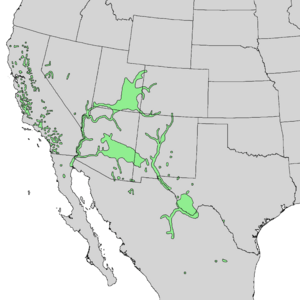Frémont's cottonwood facts for kids
Quick facts for kids Frémont's cottonwood |
|
|---|---|
 |
|
| Frémont's Cottonwood at Zion Lodge, Zion National Park, Utah | |
| Scientific classification | |
| Genus: |
Populus
|
| Species: |
fremontii
|
 |
|
| Natural range of P. fremontii | |
Frémont's cottonwood (scientific name: Populus fremontii) is a type of tree called a cottonwood. It is also known as a poplar. This tree naturally grows near rivers and streams in the Southwestern United States and parts of Mexico. It was named after John C. Frémont, an American explorer from the 1800s.
Contents
Where Frémont's Cottonwood Grows
This tree is found in many places across the Southwestern United States. You can see it in states like California, Arizona, New Mexico, and Texas. It also grows in several Mexican states, including Baja California and Sonora.
Frémont's cottonwood loves water. It grows best near streams, rivers, and springs. You will often find these trees in well-watered valley bottoms. They usually grow at elevations below 2,000 meters (about 6,500 feet).
What Frémont's Cottonwood Looks Like
Frémont's cottonwood is a large tree. It can grow from 12 to 35 meters (about 40 to 115 feet) tall. Its trunk can be as wide as 1.5 meters (about 5 feet) across. Young trees have smooth bark. As they get older, the bark becomes deeply cracked and whitish.
The leaves are shaped like a heart. They are usually 3 to 7 centimeters (about 1 to 3 inches) long. The leaves have white veins and jagged edges. In the fall, usually in October or November, the leaves turn a bright yellow color. Sometimes they can be orange or even red.
In spring, from March to April, the tree grows long, hanging flowers called catkins. After the flowers, the tree produces fruit. This fruit contains seeds that are covered in fluffy white fibers. These fibers look like cotton hanging from the branches. This is why the tree is called a "cottonwood." The wind carries these cottony seeds to new places.
The biggest known Frémont's cottonwood tree in the United States is in Skull Valley, Arizona. In 2012, it was measured to be very large. Its trunk was 557 inches (about 14 meters) around. The tree was 102 feet (about 31 meters) tall. Its branches spread out 149.5 feet (about 45 meters) wide.
How People Use Frémont's Cottonwood
Cultivation and Landscaping
People grow Frémont's cottonwood for several reasons. It is a popular ornamental tree in gardens and parks. It is also used to help restore riparian zones, which are areas along rivers and streams.
These trees are planted to provide food and shelter for wildlife. They are also used in wildlife gardens and natural landscaping. Farmers sometimes plant them as windbreaks to protect fields. Their shade is also useful for recreation areas and livestock. In the past, settlers and ranchers used the wood for fuel and fence posts.
Traditional Uses by Native Americans
Native American communities in the Western United States and Mexico have used Frémont's cottonwood for many purposes.
- Medicine
The inner bark of the tree contains vitamin C. Native Americans would chew it to prevent or treat scurvy, a disease caused by lack of vitamin C. They also used the bark and leaves to make poultices. These poultices were placed on the skin to reduce swelling or to help heal wounds.
- Art and Tools
The Pima people of Arizona and Mexico used small branches from the tree. They wove these branches into beautiful and detailed baskets. The Cahuilla people of southern California used the wood to make tools. The Puebloan peoples used the wood to make drums. The Hopi people of Arizona carve the roots of the cottonwood. They use them to create special kachina dolls.
Images for kids
-
Frémont's Cottonwood at Zion Lodge, Zion National Park, Utah
See also
 In Spanish: Álamo de Frémont para niños
In Spanish: Álamo de Frémont para niños




